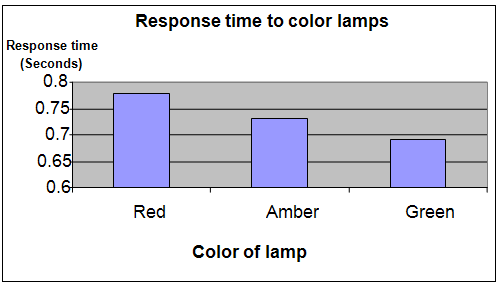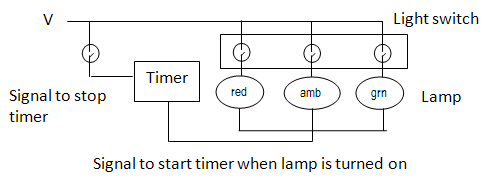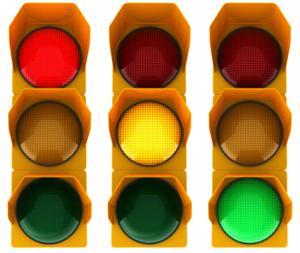| Complexity level: | 8 |
| Project cost ($): | 50 |
| Time required: | 1 hour to prepare, 1 hour for the science fair project experiment |
| Material availability: | May be obtained at an electronics hobby store |
| Safety concerns: | Basic safety requirements |
Hypothesis
Red color lights will produce the fastest human response.
Overview
Reaction time and traffic lighting
The reaction time of a driver involves the time required to mentally process the occurrence of an event, the time required for the signal from the brain to reach the muscle in the driver's limbs, and the response time of a mechanical device like the brakes in the car. Most times, drivers need to respond to the changing colors of traffic lights, the rear brake lights of the car in front or sudden incidents like a car or a pedestrian crossing into the path of his car.
Traffic lights are normally positioned at road intersections in order to regulate the flow of traffic. The colors used are red, amber and green. The red color signals the driver to stop . Amber signals the driver to prepare to stop as the light is about to turn red. Green tells the driver it is safe to drive on. Automobile lighting consists of headlight, rear lights and signal indicator lights. The headlights are normally white or light yellow in color. The rear and brake lights are red in color. Signal and turning lights are amber color. The separation of colors helps other drivers easily identify the front and rear of the car, and the intentions of the driver (for example, if the driver is about to turn right or left).
Scientific Terms
Materials
The materials required for the science fair project experiment:
- 20 children aged between 10 and 15 years old
- 1 digital timer
- 3 lamps – red, amber and green color
- sockets for the 3 lamps
- 4 switches
- sockets for the 4 switches
- copper insulated wire to make the connections
- an assistant
Procedure
1. For this science fair project, the independent variable is the color of the light used – red, amber and green. The dependent variable is the response time of the participant. This is determined by observing how quickly the participant is able to stop the timer. The constants (control variables) are the distance of the light from the participant, the distance of the switch from the participant and the lighting in the room used for the experiment.
2. The circuit is connected as shown in figure 1. The 3 light switches are toggled according to the lamp intended to be turned on. When the lamp is turned on, the timer will start simultaneously. The timer will be stopped when the stop switch is hit.

3. The setup is prepared as shown above in the room to be used for testing. The participant is seated 5 meters away from the 3 lamps. The switches are placed about 80cm in front of the participant, just within reach of the participant . The lamps are randomly switched on and the response time of the participant for each colored lamp is averaged and recorded.
4. The science fair project is repeated on all the 20 participants and the average time taken by them to respond to each of the 3 colored lamps is calculated and recorded in the table given below.


Results
The results showed that the participants responded the fastest to the green colored lamp and slowest to the red colored lamp.
|
Test |
Response time to different colored lamps (Seconds) |
||
|
Red |
Amber |
Green |
|
|
Response time |
0.78 |
0.73 |
0.69 |
The chart below represents the results of our science project experiment.

Conclusion
Our hypothesis has been proven to be false. Red color lights do not produce the fastest human response.
The response time of a driver to an event that occurs on the road is crucial in the prevention of accidents. A reaction time delayed by a fraction of a second can result in an accident or loss of a life. The response time also differs betwen expected event and unexpected events. Unexpected and surprise events require a longer response time because the driver needs time to mentally process the event before deciding on the appropriate action to take.
Also consider
To improve the reliability and accuracy of our results, a larger sample of participants should be used.
This science fair project may be repeated, by comparing response time between participants of different ages and gender.
Modify the science project experiment, using a dark room and fogged room.
References
Driver reaction time - http://www.visualexpert.com/Resources/reactiontime.html
Traffic light - http://en.wikipedia.org/wiki/Traffic_light
Automotive lighting - http://en.wikipedia.org/wiki/Automotive_lighting

